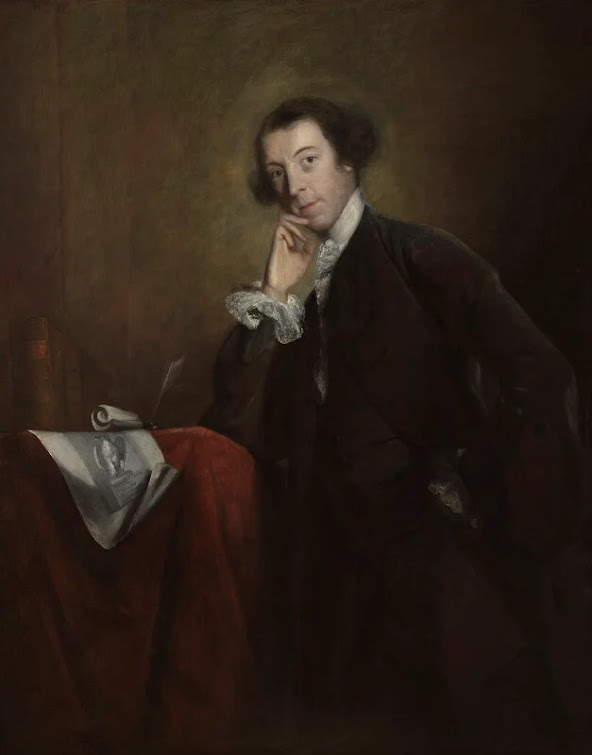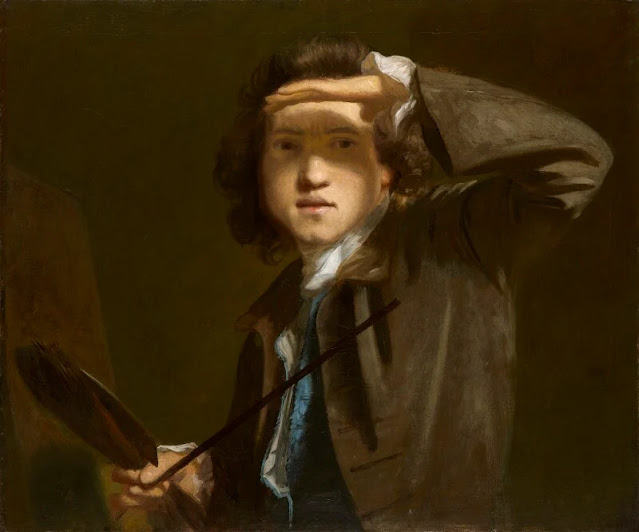 |
| c1747-49 Self-Portrait oil on canvas 63.5 x 74.3 cm National Portrait Gallery, London |
Sir Joshua Reynolds was the leading English portraitist of the 18th century. Through study of ancient and Italian Renaissance art, and of the work of Rembrandt, Rubens, and Van Dyck, he brought great variety and dignity to British portraiture. He was born at Plympton in Devon, the son of a headmaster and fellow of Balliol College, Oxford: a more educated background than that of most painters.
He was apprenticed in 1740 to the fashionable London portraitist Thomas Hudson, who also trained Joseph Wright of Derby. He spent 1749-52 abroad, mainly in Italy, and set up practice in London shortly after his return. He soon established himself as the leading portrait painter, though he was never popular with George III. He was a key figure in the intellectual life of London, and a friend of Dr Johnson.
When the Royal Academy was founded in 1768, Reynolds was elected its first President. Although believing that history painting was the noblest work of the painter, he had little opportunity to practise it, and his greatest works are his portraits. His paintings are not perfectly preserved due to faulty technique. The carmine reds have faded, leaving flesh-tones paler than intended, and the bitumen used in the blacks has tended to crack. The National Gallery, London
For more biographical details, and for earlier works see part 1 also.
This is part 2 of an 8-part series on the works of Sir Joshua Reynolds:
%20oil%20on%20canvas%20(size%20not%20given)%20Eton%20College,%20Windsor,%20UK%20.jpg) |
| 1756 Dr. John Reynolds (1671–1757) oil on canvas (size not given) Eton College, Windsor, UK |
%20Art%20Gallery%20of%20Nova%20Scotia.jpg) |
| 1756 Edward Cornwallis oil on canvas (size not given) Art Gallery of Nova Scotia |
 |
| 1756 Frances, Countess of Dartmouth oil on canvas 127 x 102 cm Museo Nacional Thyssen-Bornemisza, Madrid |
1756 Francis Hayman R.A.
Francis Hayman RA (1708-1776) and Joshua Reynolds were both born in Devonshire and had been pupils of the fashionable portrait painter Thomas Hudson. By the 1740s Hayman was painting portraits and conversation pieces as well as decorating the supper boxes of the pleasure gardens at Vauxhall Gardens with large paintings of scenes from contemporary novels and Shakespeare's plays. Hayman also did much to promote English art by his involvement in the St. Martin's Lane Academy and as President of the Society of Artists. The Academy recognised his services by appointing him as its first Librarian in 1770.
Reynolds and Hayman knew each other well and although unfinished, this is a warmly observed portrait of a successful artist of a slightly older generation who was well-known as an easy-going, clubbable character and good committee-man.
 |
| 1756 Francis Hayman R.A. oil on canvas 76.2 x 63.5 cm The Royal Academy, London |
 |
| 1756 Suzanna Beckford oil on canvas 127 x 102.2 cm Tate Gallery, London |
 |
| c1756-57 Horace Walpole oil on canvas 127.2 x 101.8 cm National Portrait Gallery, London |
 |
| 1756-60 Portrait of an Ecclesiastic oil on canvas 77 x 64 cm Museo Del Prado, Madrid, Spain |
 |
| c1756-60 James Macardell oil on canvas 74.9 x 62.2 cm National Portrait Gallery, London |
,%20'The%20Fair%20Quakeress'%20oil%20on%20canvas%2081.5%20x%2066.5%20cm%20National%20Trust,%20Knole,%20Kent,%20UK.jpg) |
| c1756 called Hannah Lightfoot, Mrs Axford (1730-c.1759), "The Fair Quakeress" oil on canvas 81.5 x 66.5 cm National Trust, Knole, Kent, UK |
%20(1748%E2%80%931789)%20oil%20on%20canvas%2076.2%20x%2063.2%20cm%20The%20Holburne%20Museum,%20Bath,%20UK.jpg) |
| c1756 Lucy Sneyd (Later Mrs Grove) (1748–1789) oil on canvas 76.2 x 63.2 cm The Holburne Museum, Bath, UK |
 |
| c1756 Samuel Johnson oil on canvas 127.6 x 101.6 cm National Portrait Gallery, London |
 |
| c1756 Sir William Chambers R.A. oil on canvas 88.9 x 68.6 cm National Portrait Gallery, London |
 |
| 1757 Miss Elizabeth Ingram oil on canvas 127 x 101.5 cm Walker Art Gallery, Liverpool, UK |
c1757-58 Colonel (later Major General) The Honourable John Barrington
John Barrington was commissioned into the 3rd Foot Guards in 1739 and transferred to the Coldstream Guards in 1746. In 1756 he was promoted colonel and appointed aide-de-camp to George II. On the formation of the 64th Foot in 1758 during the Seven Years' War (1756–1763), Barrington became its colonel. In 1758 Colonel Barrington was appointed second-in-command to Major-General Peregrine Hopson in an expedition against the French West Indies. After failing to capture the island of Martinique, the expedition proceeded to Guadeloupe, the richest of the French islands. Following Hopson's sudden death on 27 February 1759, command devolved to Barrington. He inherited an army weakened by sickness and frustrated by inaction, while his fleet was diverted to other duties.
Knowing that he could not take the island by direct assault, Barrington shrewdly set up a blockade, cutting off its supplies and forcing it to capitulate on 1 May 1759.
%20The%20Honourable%20John%20Barrington%20(1722%E2%80%931764)%20oil%20on%20canvas%2076.5%20x%2063.8%20cm%20National%20Army%20Museum,%20London*.jpg) |
| c1757-58 Colonel (later Major General) The Honourable John Barrington (1722–1764) oil on canvas 76.5 x 63.8 cm National Army Museum, London |
 |
| c1757-59 Mr. Sedgwick oil on canvas 74.9 x 62.2 cm Cincinnati Art Museum, Ohio |
 |
| c1757 Miss Mary Pelham oil on canvas 71.1 x 56.5 cm Dallas Museum of Art, TX |
%20National%20Gallery%20of%20Art,%20Washington,%20DC.jpg) |
| 1758 Annetta Coke oil on canvas 75.5 x 62.8 cm Corcoran Collection (William A. Clark Collection) National Gallery of Art, Washington, DC |
%20Goodwood%20Collection,%20Goodwood%20House,%20Sussex.jpg) |
| 1758 Charles Lennox, 3rd Duke of Richmond oil on canvas (size not given) Goodwood Collection, Goodwood House, Sussex |
1758 Lady Elizabeth Hamilton
Painted for the sitter's mother, Elizabeth, Duchess of Hamilton and Brandon (1734-1790)
 |
| 1758 Lady Elizabeth Hamilton oil on canvas 117 x 84 cm National Gallery of Art, Washington, DC |
 |
| 1758 Miss Maria Elizabeth Boothby oil on canvas 76.5 x 63.8 cm Legion of Honor, Fine Arts Museums of San Francisco |
c1758-60 William Augustus, Duke of Cumberland
Third son of George II. A lifelong soldier, described by Horace Walpole as 'proud and unforgiving, fond of war for its own sake'. His victory at Culloden in 1746 ended the Jacobite threat, but his severe treatment of the rebels earned him the nickname of "Butcher of Culloden."
 |
| 1758 William Augustus, Duke of Cumberland oil on canvas 76.2 x 63.5 cm National Galleries of Scotland, Edinburgh |
c1758-60 William Augustus, Duke of Cumberland
Cumberland is wearing a blue army uniform, although he had actually resigned his commission after defeat and political embarrassment in Austria in 1757. It seems the portrait was intended for one of Cumberland's generals, who probably preferred to have his commander wearing uniform.
 |
| c1758-60 William Augustus, Duke of Cumberland oil on canvas 74.9 x 62.2 cm National Portrait Gallery, London |
%20Museum%20of%20the%20Shenandoah%20Valley,%20Winchester,%20Virginia.jpg) |
| 1758-59 Henry Yelverton, Third Earl of Essex oil on canvas (size not given) Museum of the Shenandoah Valley, Winchester, Virginia |
 |
| c1758 Portrait of William Turner oil on canvas 123.2 x 96.5 cm Legion of Honor, Fine Arts Museums of San Francisco |
,%202nd%20Lord%20Ducie%20of%20Tortworth%20oil%20on%20canvas%2076.2%20x%2063.5%20cm%20National%20Museum%20Cardiff,%20Wales,%20UK.jpg) |
| c1758-61 Thomas Moreton Reynolds (1733–1785), 2nd Lord Ducie of Tortworth oil on canvas 76.2 x 63.5 cm National Museum Cardiff, Wales, UK |
%20oil%20on%20canvas%2076%20x%2063%20cm%20Scottish%20National%20Portrait%20Gallery,%20Edingburgh,%20UK*.jpg) |
| c1758-59 A Little Girl (possibly Lady Frances Scott, later Lady Douglas, 1750 - 1817) oil on canvas 76 x 63 cm Scottish National Portrait Gallery, Edingburgh, UK |
 |
| c1758 The Hon. Mrs John Barrington oil on canvas 76.2 x 63.5 cm Gainsborough's House, Sudbury, Suffolk, UK |
 |
| 1759 Sarah Bradley of Wakefield, Mrs William Ingram oil on canvas 90 x 69 cm National Trust, Peckover House, Wisbech, UK |
%20oil%20on%20canvas%207.2%20x%2063.4%20cm%20Scottish%20National%20Portrait%20Gallery,%20Edingburgh,%20UK*.jpg) |
| 1759 Sir David Lindsay, 4th Bart of Evelick (about 1732 - 1797) oil on canvas 7.2 x 63.4 cm Scottish National Portrait Gallery, Edingburgh, UK |
%20as%20Earl%20of%20March%20oil%20on%20canvas%2091%20x%2067.5%20cm%20The%20Wallace%20Collection,%20London.jpg) |
| 1759 The 4th Duke of Queensberry ('Old Q') as Earl of March oil on canvas 91 x 67.5 cm The Wallace Collection, London |
 |
| 1759-60 James Maitland, 7th Earl of Lauderdale oil on canvas 239 x 148.5 cm Art Gallery of New South Wales, Sydney, Australia |
 |
| 1760 Captain Adam Duncan, later Admiral Duncanand 1st Viscount of Camperdown, 1731 - 1804 oil on canvas 127 x 101 cm Scottish National Portrait Gallery, Edingburgh, UK |
%20oil%20on%20canvas%2076%20x%2063.5%20cm%20National%20Trust,%20Erddig,%20Wrexham,%20UK.jpg) |
| 1760 Edward Kinaston (d.1792) oil on canvas 76 x 63.5 cm National Trust, Erddig, Wrexham, UK |
 |
| 1760 Laurence Sterne oil on canvas 127.3 x 100.3 cm National Portrait Gallery, London |
 |
| 1760 Lord Ligonier oil on canvas 281.2 x 235.7 cm Tate Gallery, London |
 |
| 1760 Mrs. Robert Brudenell oil on canvas 75.5 x 63.5 cm Harvard Art Museums, MA |
 |
| 1760 Robert Dodsley oil on canvas 75.8 x 63.5 cm Dulwich Picture Gallery, London |
 |
| 1760-62 Portrait of a Boy oil on canvas 54 x 43 cm Private Collection |
c1760 Anne, 2nd Countess of Albemarle
Lady Anne, 2nd Countess of Albemarle, is approaching 60 in this portrait. She is the widow of William-Anne Keppel, 2nd Earl of Albemarle, with whom she had 15 children, although only four sons and two daughters survived childhood. She holds a shuttle and is engaged in ‘knotting’ – a pastime involving making knots in thread which could then be sewn as decoration onto other items. A pair of scissors and a workbasket lie on the table beside her. Her face is almost dead-white because the paint has been bleached by the light.
 |
| c1760 Anne, 2nd Countess of Albemarle oil on canvas 126.5 x 101 cm The National Gallery, London |
 |
| c1760 Elizabeth Gunning, Duchess of Hamilton and Argyll oil on canvas 238.8 x 147.3 cm Yale Center for British Art, New Haven, Connecticut |
1760s An Officer on Horseback
Reynolds (1723-1792) captures a moment of stillness amid the chaos of battle. A soldier, dressed for battle, rears his horse. In the distance, plumes of smoke reach towards the sky, alerting the viewer to the danger. This study for an equestrian portrait was the third composition Reynolds painted onto the same piece of canvas. Two abandoned portraits are visible in the X-ray of the painting – one of a young boy above the horse’s mane, the other an older man, now upside down, just below. The picture remained in Reynolds’ possession and was acquired by the painter and founder of Dulwich Picture Gallery, Francis Bourgeois (1753-1811), at the Reynolds studio sale of 1796.
 |
| 1760s An Officer on Horseback oil on canvas 77.3 x 64.5 cm Dulwich Picture Gallery, London |
%20black%20and%20white%20chalk%20and%20stump,%20on%20buff%20laid%20paper%2041,5%20x%2026%20cm.jpg)
'%20oil%20on%20canvas%2074%20x%2062%20cm%20Royal%20College%20of%20Music,%20Londonjpg.jpg)
%20oil%20on%20canvas%20123%20x%2099.5%20cm%20Mount%20Edgcumbe%20House,%20Torpoint,%20UK.jpg)




%20oil%20on%20canvas%2046%20x%2036%20cm%20The%20New%20Art%20Gallery%20Walsall,%20UK.jpg)

%20oil%20on%20canvas%2076%20x%2063.5%20cm%20National%20Maritime%20Museum,%20London.jpg)


%20and%20Martha%20Neate%20(1741%E2%80%93after%201795)%20with%20His%20Tutor,%20Thomas%20Needham%20oil%20on%20canvas%20168%20x%20180.3%20cm%20The%20Metropolitan%20Museum%20of%20Art,%20New%20York.jpg)
%20oil%20o%20canvas%2076.2%20x%2063.5%20cm%20The%20Barber%20Institute%20of%20Fine%20Arts,%20Birmingham,%20UK.jpg)
,%20MP,%20with%20'Jersey'%20oil%20on%20canvas%20127%20x%20101.5%20cm%20National%20Trust,%20Saltram,%20Plymouth,%20UK.jpg)
%20oil%20on%20canvas%20123.5%20x%2098%20cm%20Newstead%20Abbey,%20Ravenshead,%20UK.jpg)
%20oil%20on%20canvas%20127.1%20x%20101.8%20cm%20The%20Box,%20Plymouth,%20UK.jpg)






,%20Bt%20oil%20on%20canvas%2073.7%20x%2061%20cm%20Tabley%20House,%20Knutsford,%20UK.jpg)



%20oil%20on%20canvas%20231%20x%20147.5%20cm%20Cartwright%20Hall%20Art%20Gallery,%20Bradford,%20UK.jpg)





%20oil%20on%20canvas%2076%20x%2062%20cm%20Usher%20Gallery,%20Licoln,%20UK.jpg)


,%20and%20his%20Son,%20Sir%20Francis%20(1752%E2%80%931820),%204th%20Baronet%20oil%20on%20canvas%20128%20x%20102.7%20cm%20National%20Maritime%20Museum,%20London*.jpg)
,%202nd%20Duke%20of%20Grafton%20oil%20on%20canvas%20236%20x%20145%20cm%20Examination%20Schools,%20University%20of%20Oxford,%20UK.jpg)

%20oiloil%20on%20canvas%2076.2%20x%2062.8%20cm%20Christ%20Church,%20University%20of%20Oxford,%20UK.jpg)

%20(1680%E2%80%931770)%20oil%20on%20canvas%20127%20x%20101.6%20cm%20National%20Army%20Museum,%20London.jpg)
%20oil%20on%20canvas%2076.8%20x%2063.2%20cm%20V&A%20Museum,%20London.jpg)
%20oil%20on%20canvas%2073%20x%2062%20cm.jpg)
